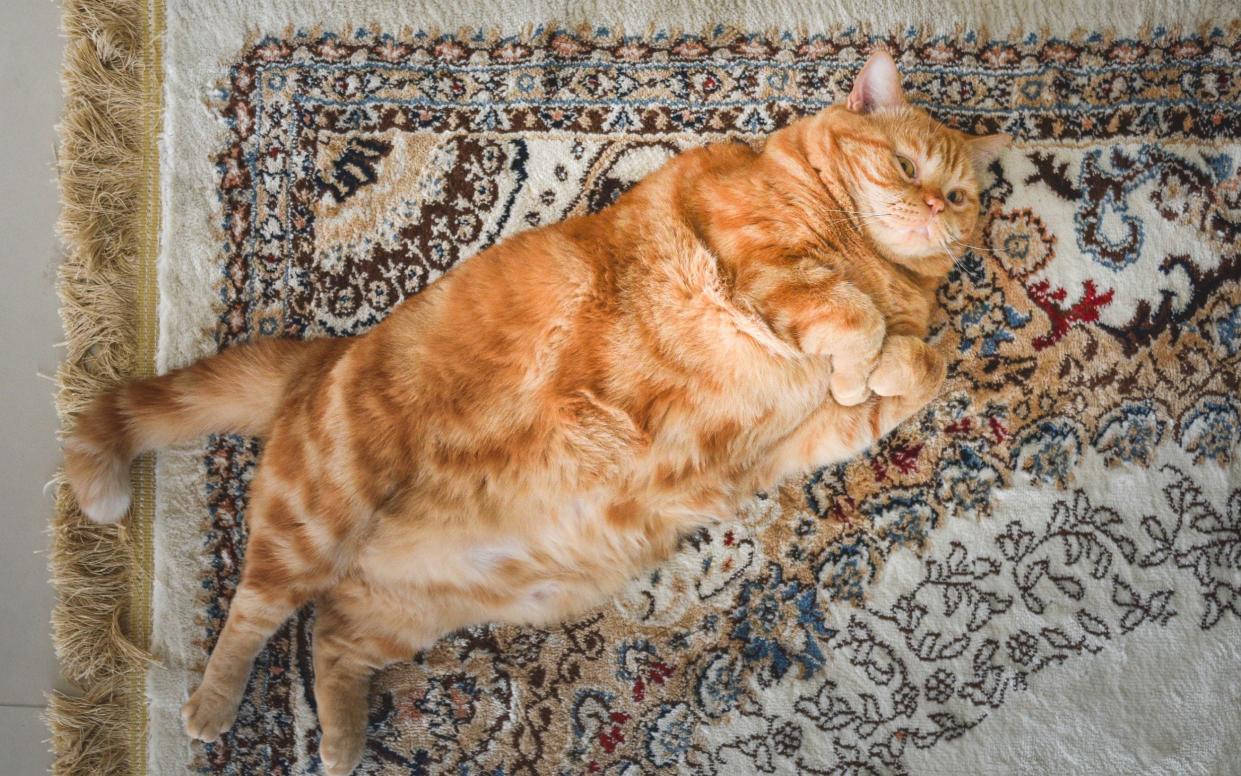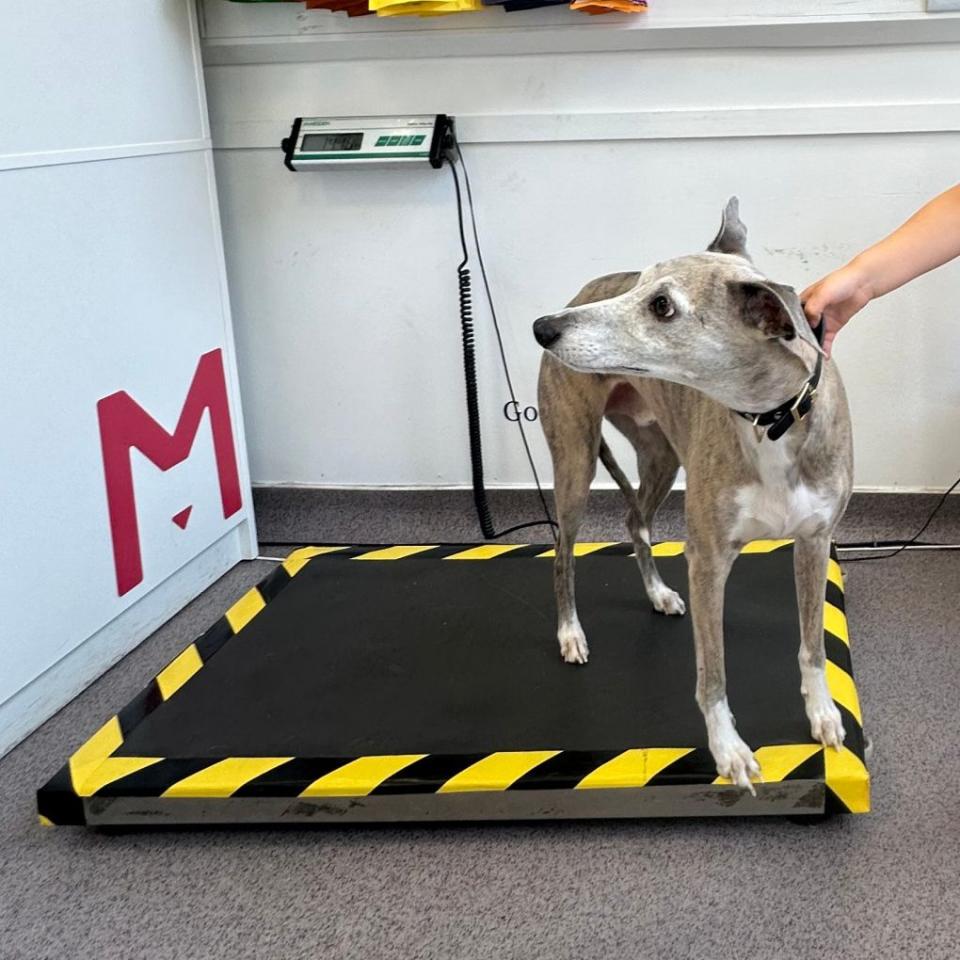Watch out, fat cats – Ozempic is coming for pets

Rudy, our whippet, is finely built and runs like the wind, so I assumed he’d never have to watch his weight, even if he does spend much of his life asleep in his envelope bed or stealing from the baby’s highchair. Yet now aged six, he’s suddenly looking a little stout – so much so that my vet friend, Alicia Fox-Pitt, accuses him of being fat. Fat!
When I take him to get weighed at our local veterinary practice, the nurse confirms that my whippet is officially a whoppet. He weighs in at a little over 14 kg, which is within the healthy range for a whippet (the average weight for the breed is between nine and 19kg) yet fails the body condition test, which according to the nurse is a more telling barometer than the scales. “He could probably do with losing a kilo,” she tells me, feeling his waist and ribs. “He’s still got a waist yet it could do with more definition and there’s a little too much fat over his ribs.”
When I report back to Fox-Pitt, who is a vet in Dorset, she tells me that she’d give Rudy a body condition score of six out of nine: optimum is 4.
I feel bad that I’ve let him get out of shape yet it seems I’m not the only dog owner to have their head in the sand about their pet’s weight. About 70 per cent of us believe our pets to be the perfect size, according to a survey by UK Pet Food, when the terrifying truth is that one in every two dogs is now classified as overweight or obese (in America it is 60 per cent). This is still less than the number of adult humans – 64 per cent are overweight and obese – but experts believe pet weight problems have the same underlying causes as humans. “Obesity runs in families – part of this is genetic and the rest is environmental – attitudes to food and activity,” explains Professor Alex German, a small-animal obesity expert, who has been running a specialist obesity care clinic for dogs and cats for almost 20 years. “There is a similar association between obesity in owners and their pets. The fact that most people see their pets as another member of the family, may well explain the similarities between obesity in children and pets.”

Fox-Pitt agrees that we anthropomorphise our pets, which makes us inclined to feed them too much. She’s come across owners who give their dogs milk in their “breakfast cereals”, bake them birthday cakes and even serve them tea in their dog bowls. Meanwhile the dog treat aisle in the supermarket is getting longer each year, even though vets maintain treats should make up no more than 10 per cent of a dog’s diet.
Fox-Pitt, who has treated Labradors that are so heavy they cannot be lifted onto the examination table, assures me that Rudy’s extra pounds won’t be affecting his health too much. Obesity, however, is a serious problem, shortening a dog’s life by up to two years and exacerbating diseases such as arthritis, heart disease and respiratory problems, particularly in brachycephalic flat-faced breeds such as the Pug. German is seeing an increasing number of very obese dogs (40 per cent above optimum weight), who subsequently find it more challenging to shed weight, simply losing muscle rather than reaching their target. Feline obesity is also a growing problem, with one in every three cats now overweight or obese in the UK.
It’s no wonder, then, that drug companies are racing to create a dog and cat version of human diabetes and ‘weight loss’ drugs Ozempic, Wegovy and Mounjaro, to make it easy for owners to control their pet’s weight. Better Choice, a pet pharmaceutical company with a history of repurposing human drugs for animals, plans to spend $1.5 million (£1.185million) on a trial for a pet-based GLP-1. This class of medications was originally developed to control blood sugar levels in people with type 2 diabetes by stimulating the pancreas to release insulin, while suppressing the release of another hormone called glucagon.
Studies show that GLP-1s also curb hunger by slowing the movement of food from the stomach to the small intestine, which is why they’re now prescribed for weight loss, too. In a small study, a new GLP-1 implant for pets by biotech start-up Okava Pharmaceuticals helped cats lose at least 5 per cent of their body weight over 112 days.
In dogs, diabetes is akin to type 1 diabetes in humans, therefore an Ozempic-type drug is unlikely to be effective to treat diabetes, German says. However, he believes that it could have a stalling effect on dogs’ appetites and sees no other reason why it would not be effective as a treatment for obesity, ideally with appropriate nutrition – assuming, of course, that it was proved safe and effective in trials. “By helping them to stay slimmer, it could help prevent them from developing diabetes in the first place,” Fox-Pitt adds.

Pet diet pills are not a new concept. In 2007 two weight loss drugs were approved, Slentrol, a weight loss medication for dogs, and Yarvitan, which successfully suppressed appetite and had no side effects, yet they were both subsequently discontinued due to lack of demand.
“Most vets did not prescribe it, feeling that obesity should not be treated by a drug, and the owners of dogs who took it were disappointed by the results – it reduced hunger yet changed the relationship between dog and owner. Dogs showed less interest in them.”
Yet attitudes to weight loss drugs have changed since then; with so many humans taking them successfully, German expects they will be better accepted by the veterinary profession. “There is less obesity-related prejudice now,” he says. “The view that obesity in pets is the fault and responsibility of the owner is flawed as it can be genetic and is more complex than a failing owner. We should be supporting owners as best we can.”
He currently uses a therapeutic weight reduction diet to help overweight dogs lose weight along with a bespoke exercise plan and methods to prolong meals. “We use puzzle feeders that make meals last longer, which improves satisfaction,” he says. “Although by no means perfect, diet-based strategies are much more successful in dogs than in people.” They lead to greater mobility and quality of life along with an average at his clinic of 20 to 25 per cent weight loss. This, he proudly points out, is equivalent to bariatric surgery, which is still the most effective weight loss option in humans despite all the drugs that are now available. “As yet, there is no bariatric surgery for dogs,” he says. “Arguably, it is not ethical to do so given that our current strategies are effective.”

Indeed, Fox-Pitt is successfully using a therapeutic weight reduction diet on her previously overweight labradoodle Nala. She was feeding her insect-based dog food as it was better for the planet but Nala was hungry all the time and constantly begging. Since swapping her on to satiety food with a high protein and fibre content Nala settles calmly in her bed after meals. “We’re in a unique position to moderate our dog’s diet; we control what they eat and how much they exercise without the same mental health implications as with humans,” she says.
The RSPCA’s minimum exercise recommendation for dogs is 20 to 30 minutes each day but Fox-Pitt walks her two dogs, Nala and Pip, a whippet, for an hour off the lead each day and suggests I start doing the same with Rudy. “You’ll feel better, too, if you walk him for longer – dogs have amazing mental and physical health benefits for their owners - and many of these come from getting outside and walking more” she says.
For some dogs, though, long walks each day aren’t an option – Labradors, for example, which according to German are genetically predisposed to obesity, often suffer from joint problems. If this is the case, Fox-Pitt recommends taking them to a hydrotherapy clinic; exercising with water resistance works the cardiovascular system and builds muscle strength without putting too much pressure on joints. “It’s expensive but it’s very effective for overweight dogs who can’t go for walks,” she says.
For a dog such as Rudy, who is only a little bit fat, German, who offers remote appointments for overweight dogs at his clinic in the Small Animal Teaching Hospital of the University of Liverpool, suggests cutting down their meals by 10 to 20 per cent before investing in a satiety diet. I don’t think he’ll tolerate this, though. We’ve tried it before and he simply hounds my husband until he’s given what he considers to be his rightful amount.
Cutting down on treats is another obvious step but Rudy doesn’t get any; he’s an expert thief who steals biscuits off our five children and hoovers up what they drop under the table. Fox-Pitt tells me to shut him away when the children are eating to stop him filling up on scraps yet he cries like a baby in his crate and none of us can stand it. Bring on the Ozempic, I say.

If it does hit the pharmacies, German does not rule out prescribing it, so long as it is not compromising the supply chain of human weight loss medications. Neither does Fox-Pitt, who can see a dog Ozempic working well where an owner is unable to exercise their dog or incapable of controlling their diet. “If a member of the household has dementia, they will often forget they’ve fed the dog,” she says.
It’s never going to be a magic bullet, though, German warns. He prescribed the previous weight loss drugs and only saw mixed results. “A therapeutic diet is safe and effective,” he says. “Given that we already have an option that can work as well as drug therapy, why rush to use them?”


